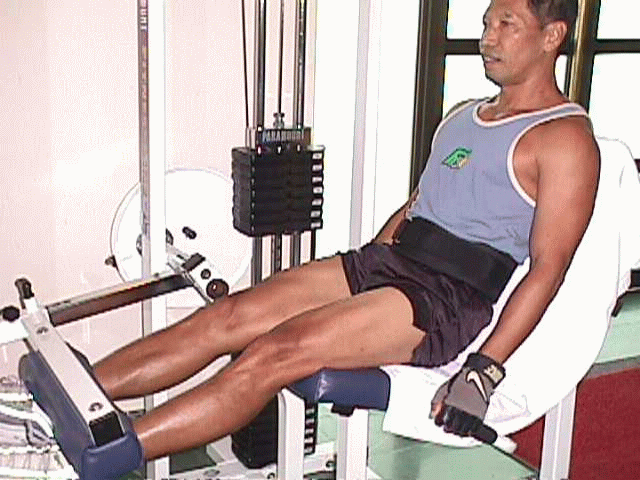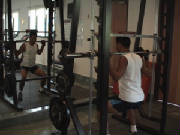 |
 |
|
Built on a solid fitness foundation
|
"Train
for your sport." That's what the fitness instructors are telling us these days. And it's true; you need to train your body
to be able to meet the particular physical demands of any athletic activity. But what exactly does "sport-specific training"
mean for tennis players?
Watch any match and you'll get a general idea: Every player needs to stop and start quickly,
scramble to get to wide balls, and use the core of the body to provide balance and rotate through ground strokes, all while
hitting with power and accuracy. These skills don't just happen; they're all built on a solid fitness foundation. Because
of that, a well-structured conditioning and strength program that focuses on injury prevention and performance enhancement
should be an integral part of every tennis player's training plan.
For years, the USTA sports-science committee
and staff have been looking at the physical makeup of elite tennis players, identifying specific areas where they're weak
and strong. Using a Cybex 6000 Isokinetic Testing Machine, we have been able to measure the relative strength of many muscle
groups throughout players' bodies and identify strength imbalances that come from playing tennis and can lead to injury. With
the results of these tests, we develop training plans that show players how to combat these deficiencies in a precise way

Here's
a look at a tennis player's major muscle groups, with exercises to keep dominant and weaker sides in balance
MUSCLE
GROUPS:
SHOULDER The muscles that internally rotate the shoulder (pectoralis major,
anterior deltoid, latissimus dorsi) are typically 33 percent stronger than the external rotators (posterior deltoid, infraspinatus)
on the dominant side in tennis players. Every time you hit a serve or a forehand you use your internal rotators, and they
become quite strong. The external rotators typically must be strengthened to maintain normal shoulder function and prevent
injury.
FOREARM AND WRIST The muscles in the dominant forearm and wrist are 30 percent stronger than the
same muscles on the non-dominant side. Within the dominant side, the pronator muscles, which rotate the palm inward, are 40
percent stronger than the supinators, which rotate the palm outward. The pronation that occurs in serves and ground strokes
contributes to this strength imbalance.
LEGS The quadriceps, crucial muscles
for getting up for serves and exploding toward the ball on ground strokes, are twice as strong in tennis players as the hamstrings.
This is not an imbalance to be worried about, but a ratio needed by every athlete.
TRUNK Because they contract
their stomach muscles with every stroke, tennis players typically develop abdominal muscles that are stronger than their lower-back
muscles. This is in contrast to most people, who have stronger muscles in the lower back.
OBLIQUES These
are the abdominal muscles just above your hips along the sides of your torso that cause the trunk to rotate when they contract.
Tennis keeps trunk-rotation strength balanced on both sides of the body because players hit both forehands and backhands,
which require these muscles to be strong in both directions. But because these muscles facilitate the rotation necessary for
open-stance strokes, tennis players should train them regularly.

EXERCISES:
Shoulder Exercise: To keep shoulder strength balanced, do rows. With a dumbbell
in one hand, bend and anchor your body by putting your opposite hand and knee on a bench or chair. With your back flat and
arm straight up and down, slowly pull the weight up to the center of your body. Hold and release to starting position. Do
three sets of 10 to 15.
Forearm and Wrist Exercise: To keep forearm strength balanced and help prevent tennis elbow, perform wrist extensions.
Sit with one end of a light exercise band under your feet. Rest your right forearm on your thigh so your hand is over your
foot and hold the end of the tube in your hand, palm down. Place your left hand, palm down, over your right forearm for stabilization.
Raise your right hand, keeping your forearm on your thigh. Hold for one second; do 15 times with each arm.
Trunk Exercise: To strengthen your lower back and rebalance the strength in your core, try performing Superman exercises.
Lie face down on the floor, arms fully extended over your head. Lift your arms and legs simultaneously. Hold for one to five
seconds, release, and return to starting position. Work up to 20 repetitions.
Obliques Exercise: To keep your obliques strong, do crunches with a twist. Lie on the floor with knees bent, back flat
against floor. Place your arms on the same side of your body, holding a tennis racquet in both hands. Bring both arms up and
across your body in a diagonal movement while using your trunk to rise up. Do 20 reps and switch sides. Legs Exercise: Strength can be built in the quads with standing squats. Put
a barbell of comfortable weight across your shoulders (or use a Smith machine), point your feet slightly outward, bend your
legs 90 degrees, then power the bar up until you're standing. Keep your back straight throughout. Do 15 repetitions
|


![]()
![]()


